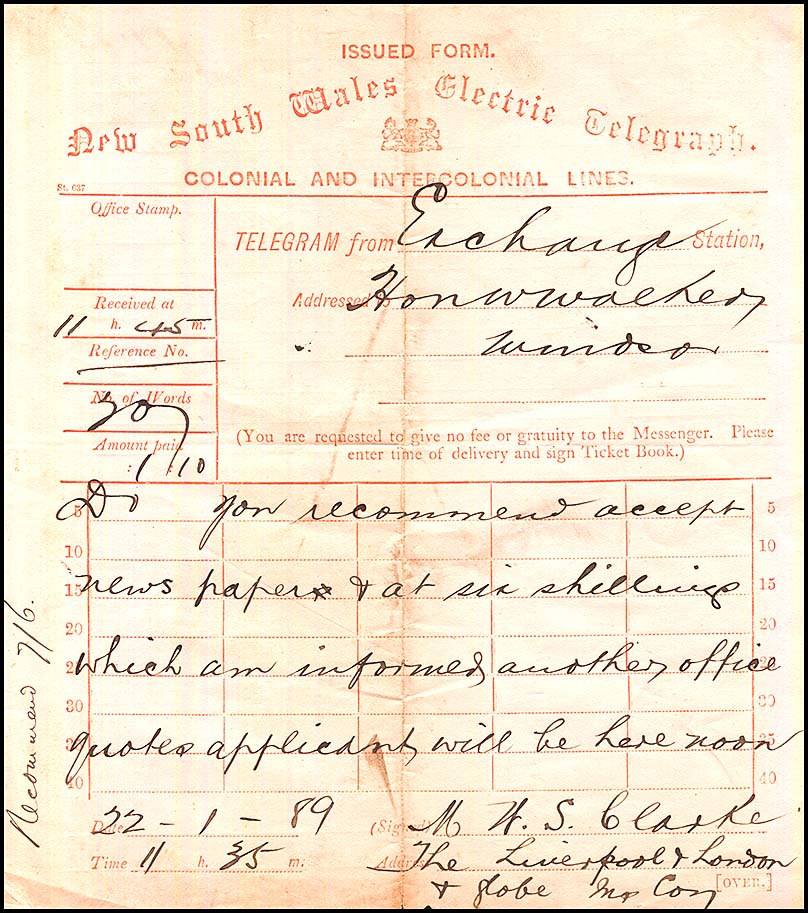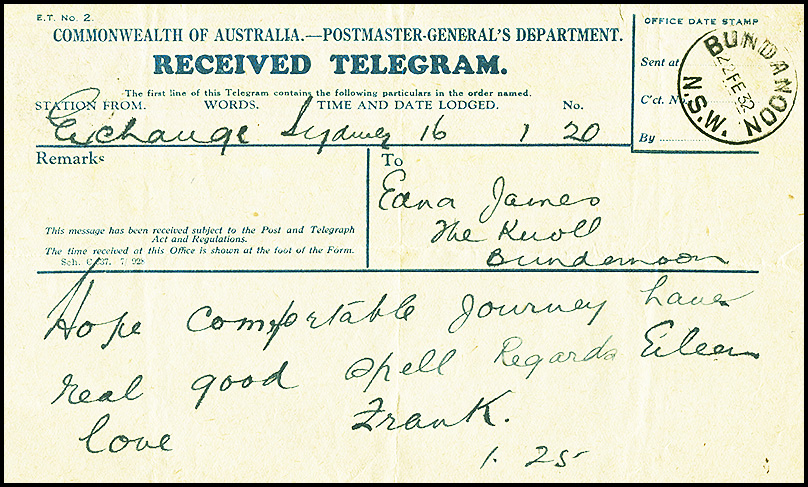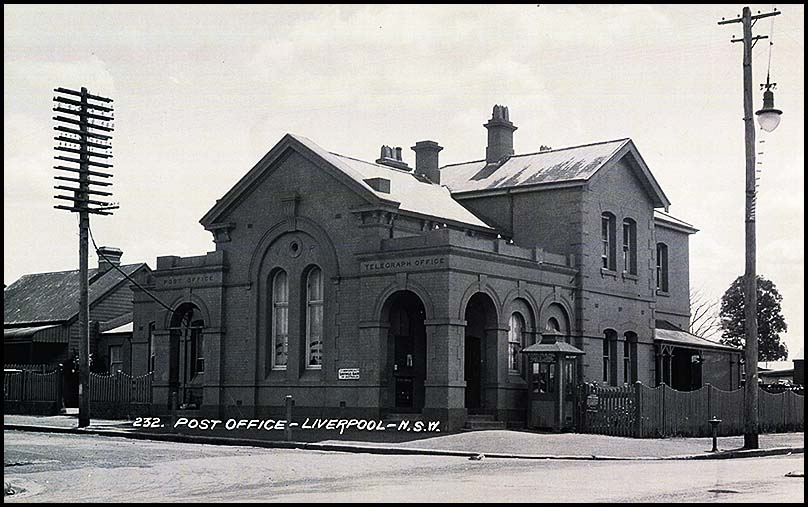Telegraph Offices on the first line.
- Australia 1901-1988
- New South Wales
- Overview of NSW
- Telegraph lines
- Telegraph Offices
- Date stamps
- Forms
- Envelopes
- Instructional annotation
- Collect
- Delayed
- Free
- Immediate Urgent
- Reply paid
- Rates
- Stamps
- 1871 Telegraph stamps
- 1885 proposal
- 1893 proposal
- Queensland
- South Australia
- Tasmania
- Victoria
- Western Australia
- International
- Special aspects
There are few records relating to the five Telegraph Offices on the first line of telegraphs in NSW. These Telegraph Offices are listed in the table below:
| Exchange | Liverpool | Parramatta | Redfern | South Head |
|
The (Sydney) Exchange was opened on 30 December 1857. Two rooms of the building had been let to the Telegraph Department for use as a temporary Telegraph Office. It was therefore the first Telegraph Office in the Colony. Lines connected from there to South Head and to Liverpool via Redfern. In early January 1858, Mr. Martindale had authorised the following notice to appear in newspapers: "On the 26th instant, such of the public as may be desirous of seeing the Telegraph instruments at work will, as far as practicable, be admitted into the Office in the Exchange, between the hours of 9 a.m. and 6 pm. in parties not exceeding thirty at one time". In September 1860, the Government had decided it would remove the Telegraph Office from the Exchange to a new building which it proposed to erect to the south of the Post Office. This decision was taken despite the fact that the Exchange had provided the space for the Telegraph Office for the three years since the first line had been constructed free of rent. When the agreement between the Government and the Exchange terminated, the Telegraph Office moved to a new Office in George Street. The Maitland Mercury of 31 January 1861 described the separation as follows: "The adjourned half-yearly meeting of the shareholders of the Sydney Exohange Company waa held on Monday, Mr. T. O. Breillat in the chair. The report stated, amongst other matters, that the Government having declined to pay a fair rental for the premises occupied by the Telegraph Department, the requisite three months' notice had been given, the premises had been vacated, and were now leased for three years at £125 per annum". EXCHANGE TELEGRAPH OFFICE. TO THE EDITOR OF THE (Sydney) EMPIRE. SIR - The public have frequently commented on certain offices, and the above may be allowed to join in the category. From the central position of the Exchange, a telegraph office is placed there (a branch office) for the convenience of those parties who have their stores and houses of business contiguous to the establishment. Now, Sir, from certain, personal knowledge, I have often seen merchants and, others drop, into this office for the express purpose of transmitting a message in order to facilitate its despatch. They refrain from going to the head office where it would meet with every attention and be forwarded instanter. Well, after waiting for some considerable time, they are reluctantly compelled to proceed to the head office. You will now naturally inquire the cause of this delay, which is easily answered - viz: The party in charge of this office is either enjoying comfortable confabulation with some of his "chums" or else studying the politics of the day in the Exchange reading room. Now, Sir, what I maintain is this: that they ought to abolish the office or appoint someone who would pay more attention to his duties. I hope this may prevent the necessity of the former and check the present predeterminating system. Apologising for troubling you with this communication, I subscribe myself, Sir, QUID NUNC. A new Telegraph Office was opened at the Exchange on 30 October 1885. |
|
Personnel: January 1868: Mr. William Hilliard was appointed as an Operator in the Electric Telegraph Office. |
|
Early usage: The earliest indication of the operation of (The) Exchange is a delivery form (NC-DO-8Ab) used for a message from the Exchange to Windson on 22 January 1889. |
|
|
|
Date stamps: No special date stamps appear to have been issued to (The) Exchange for use with telegraphic work. The postmark shown here was issued for use with ordinary postal items.
|
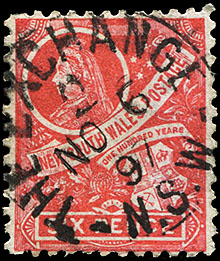 6 November 1897. |
| Liverpool.
The Liverpool Telegraph Office was opened at the Railway Station on 26 January 1858 and operated there until 6 February 1871. It re-opened at the Railway Station on 22 March 1873 and was amalgamated to become the Post and Telegraph office on 12 July 1878. On 14 March 1878, the Gazette called for tenders "from persons willing to let to this department a building suitable for a Post and Telegraph office at Liverpool. Tenderers must state rent per annum (including rates and taxes) required". One might infer that this approach was unsuccessful because the Gazette of 14 October 1879 announced that the tender submitted by Aspinall and Spice had been accepted for the construction of a Post and Telegraph Office. The Liverpool Post Office had been one of the first to be opened in New South Wales - on 1 March 1828. |
|
|
|
One report of an inspection visit to Liverpool during the construction of the Telegraph line and the Railway reported the folowing: "The Electric Telegraph post and wire are neatly all laid down on the line between Sydney and Liverpool. One word about the BonifacesProprietor of a Hotel or guest house. of Liverpool. We went into two or three public houses in the town, in the vain hope that we might find out where we could be decently accommodated. Those Inn-keepers who were clean were uncivil, and those who were civil were dirty. In the first house we visited, Mrs Boniface, for we did not see her lord and master, if she had any (which is questionable seeing that she had the appearance of being a termagant) was as saucy as the devil, and sour looking enough to turn a pail of new milk into curds. The return train started for Sydney at a quarter to six. Farewell Liverpool, we may never see thee again, and sooth to say, we shall not be sorry for it if we don't". Thankfully things change for the better!! On 27 December 1879, the Cumberland Mercury reported the story of the laying of the Foundation stone - BY A WOMAN!!! - and one of the consequences which ensued: "The corner stone of the new Post and Telegraph Office was laid on Friday last, 19th inst by Mrs. N. G. Bull, Cabramatta Park, near Liverpool, in the presence of Messrs. McCullock, Byers and Thompson M.L.A.s and a large number of the residents of Liverpool and district. The school children, under the management of Messrs. Stratford and Long, were present. Ald. Wilson said it was a very pleasing duty for him to-day to present to Mrs. Bull the mallet and trowel and, as it was the first occasion for the past twenty years that any thing of this sort occurred at Liverpool, it gave him much pleasure to do so. Mrs. Bull then laid the stone an the usual way. Mr. Bull said I think, on an occasion like this, it was a matter of rejoicing to the people, as we all knew the great boon it was to have direct communication, and likewise the great disadvantage there was in having our Post Office kept by a storekeeper. He thanked the aldermen and the people on behalf of Mrs. Bull, for the handsome mallet and trowel, and they may be sure that Mrs. Bull and he would prize it very much. Mr. McCullock said that it gave him great pleasure to be present there to-day, and he was pleased to see so many people on that occasion. He took a great interest in getting the new Post Office for them and, from all he saw, it would be quite an ornament to the town. He was sorry his friend Mr. Lackey could not be present; he had made arrangements for coming on that day but, receiving a circular from the Mayor, he had made other arrangements, and after the matter was explained, he could not come. He, Mr. McCullock, thought it it very mean, contemptible, ungentlemanly and unwarranted conduct, on the part of the Mayor, and he supposed that no doubt he was sitting at home at the present moment regretting his folly. Mr. Wilson called for three cheers for the Queen. The school-children sang "God Save the Queen". The children were then regaled with sweetmeats, etc. Great credit is due to Mrs. Aspinall for the manner in which the tables were laid out and her attention to the guests. "INDIGNATION MEETING—An indignation meeting was held on Thursday evening last in the front of Host Marsden's, condemning the conduct of the Mayor (Mr. Scrivener). There was one of the largest attendances seen in Liverpool for many years. Ald. Whiteford, on the motion of Ald. Marsden, took the chair and stated that the business was to contradict the impertinent circular sent to the residents and others. Ald. Wilson stated that he was quite sure the whole of the inhabitants were in favour of Mrs. Bull laying the stone, perhaps with a few exceptions, such as Dr. Strong, Mr. Priddle and the Mayor. He believed that if Strong and Priddle had to get their living by the goodwill of the people, they would not earn their salt. He found that everything that was done in Liverpool for the good of that place, that it was the working classes who did it. Mr. Bull said very that he was very sorry that there was any trouble over the matter. He was quite satisfied with the names on the requisition that it was no clique. He would read them also the circular. The following motion was then put to the meeting, and carried without a dissenting voice — "That Mrs. N. G. Bull is a fit and proper person to lay the foundation stone of the new Post and Telegraph Office". Personnel: Mr. Frederick Brown was appointed as an Operator in the Electric Telegraph Office at Liverpool in January 1868. |
|
A rubber circular TELEGRAPHS date stamp (RC1 - T) was used at the Liverpool Office.
|
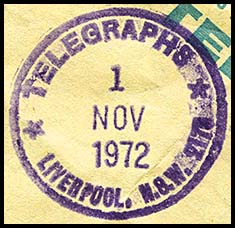 1 November 1972. |
|
1. Parramatta nearly gets its line. Although the Railway Line - and therefore the Telegraph Line - passed through Parramatta en route to Liverpool, "we understand that we are not to be favoured with a branch of the telegraph in Parramatta. The reason assigned for this is on account of the expense, but the additional cost would make an exceedingly small item in the expenditure required for the erection of the telegraph - a mere drop in the bucket. Some person may say in objection, what do you at Parramatta, so close to Sydney, want with the telegraph? And another may hint what have you to communicate when you get the telegraph? But the latter query might be reasonably put to many more places than Parramatta; and we submit we ought to benefit in the expenditure of the public money as much as other towns in the line of road. Parramatta is the third town in regard to size in the colony, only a hundred or two behind Maitland in population. Our newly elected members might beneficially exert themselves to gain this advantage for Parramatta. A good situation for the branch to terminate at would be where the new market is to be erected; the plan of which very neat building, as it will be, was kindly drawn out by Mr. P. O. Darvall, the Police Magistrate" (Sydney Morning Herald 18 February 1858). After a very serious railway derailment in July 1858 killed two people and injured a very large number, Parramatta was promised a Telegraph Office would be opened near the line "as soon as instruments could be procured". The Sydney to Parramatta Railway line had opened on 26 Seotember 1855. So by the early 1860s, the railway from Sydney to Parramatta was being fully utilised by man and beast alike - but sometimes the separation was confused: "At the district court, Mr. Holroyd has been pulling up the railway officials for sending a cow of his from Parramatta to Sydney by a passenger train instead of a goods train for which, compliments to "Crunmmie", her Majesty's Treasury will have to pay £2" (Goulburn Herald, 21 May 1862). In a major Parliamentary Statement on the lines to Bathurst and the Hunter dated 13 August 1858, Mr. Martindale noted that "The line to the Hunter should leave the southern and western lines at Parramatta and follow the main road to Windsor, thence to Wiseman's Ferry and, via Wollombi, to Maitland and from Maitland along the line of railway to Newcastle and the proposed extension to Singleton. The length of the line as far as Newcastle would be about 142 miles; the estimated cost £13,000. The stations might be at Parramatta, Wollambi, West Maitland and Newcastle". |
2. The Post and Telegraph Offices 2.1: The second Office - 1870. "Our thanks are due to the Hon. Daniel Egan for the boon he has conferred on us in removing the Post and Telegraph offices from their former inconvenient sites to the present commodious and centrally situated premises in Church Street. Till recently, the TelegraphOffice was at the railway station, nearly half-a-mile from the business portion of the town and, to get to the post office for letters, one would have to go up a lane. Now,however, they are in the same building in Church Street, a few doors from the Commercial Bank". (Empire, 22 June 1870). |
2.2: The third Office. In the Legislative Assembly on 2 April 1874:
Mr. Parkes said an application had been made to the Government for the erection of premises for the Telegraph Office and the Post Office, Parramatta. It was considered, after some inquiry, that, as the premises were centrally situated and in good condition, there was no present urgency for a change; but a final decision had not been arrived at". Towards the end of 1876, two reports were printed about the site selected for the new Post and Telegraph office. Both are repeated here:
Three years later, conditions had changed and, in the Legislative Assembly on 24 April 1877, "Mr Parkes, in answer to Mr. Taylor, said one operator, one probationer and one messenger were employed or admitted in the Parramatta Telegraph Office. The Postmaster-General was not aware that, in consequence of the exposed and inconvenient nature of the building, residents near it had no confidence in the privacy of telegrams they sent. Tenders would be called for a new building as soon as plans and specifications were prepared and Parliament had voted a sum for a site"". By early 1878, "A great many complaints are constantly being made by those who often avail themselves of the wire, in not being able to use it after 8 o'clock p.m. Surely some arrangements could be made with our Post Master (Mr. Dee) to suit the convenience of the public" (Evening News 21 February 1878). The Sydney Mail of 8 June 1878 reported the next development: "Wednesday was quite a gala day at Parramatta, the occasion being the laying of the memorial stone of the new Post and Telegraph office there by Mrs. Taylor, the wife of Mr. Hugh Taylor, the member for Parramatta, that lady having, at the invitation of the residents generally, consented to officiate at the ceremony. A special train left Redfern at 10 o'clock, conveying the Colonial Secretary, the Minister for Works, Mr. Coonan, M.L.A., and other gentlemen, as well as the inmates of the Deaf and Dumb Institution, who had been invited to be present at the proceedings. About 1 o'clock all the children of the Orphan institutions were mustered in the park, where they were suitably refreshed, and had a number of toys distributed amongst them with almost unsparing hands ... the company adjourned to the place where the event of the day was to take place, in Church Street. At the appointed time, a large crowd, amongst which were many ladies, had assembled. Previously to the stone being lowered into position, the Rev. G. Macarthur, on behalf of Messrs. Stewart, Dennis, Tunks, Macdonald and others, presented Mrs. Taylor with a silver trowel and a myall mallet. They were both beautiful implements and the trowel had an inscription on it recording the name of its recipient and referring to the event both articles were to be tokens of. The ceremony of laying the stone having been completed, Mr. Taylor, Mr. Burns, Mr. Fitzpatrick and Mr. Sutherland addressed the meeting and the proceedings terminated with three cheers for the Queen". The Sydney Morning Herald of 6 June 1878 provided the following description of the building: "Messrs. Hart and Lavers contractors for the new Post and Telegraph office, commenced their work during the past fortnight and appear to be carrying it out with energy. The building will be one of the handsomest and most convenient of its class out of Sydney. The business portion of the premises will be approached through an area extending along the whole front and 7 feet wide. The ground floor contains the main Post Office 35 feet 3 inches by 21 feet 6 inches; postmaster's private office 17 feet 6 inches by 14 feet 6 inches. A telegraph lobby in which to write telegrams; a paper store and a hall and passage 7 feet wide. On the same floor area are a dining-room, a kitchen, a scullery, a servant's bedroom, pantrv and a battery store for the storage of telegraph instruments. At the rear are coal sheds, stables, closets and urinals The total depth of the main building is 46 feet, and of the portion to be occupied as kitchens, etc 40 x 21 feet. Whilst the length of the verandahs on the ground floor, exclusive of the arcade, is 88 feet and width 6 feet. The upper floor contains a drawing-room, a recess, four bedrooms, a passage and a landing and bathroom. The height of the lower rooms is 13 feet 6 inches and of the upper 13 feet and between the two there is a double floor, to prevent sounds from the private rooms above being heard in the other division of the premises. |
|
The building will be suitably situated in Church Street, near the Presbyterian Church and, as there is an unobstructed view of the north elevation, the edifice will stand out in fine relief from adjacent properties. The style of architecture is composite, and the stone front, with its circular headed openings, cornices, etc will present quite a massive appearance. On the front are to be four granite columns, supporting arches over the balcony, and on both sides the window openings will be large and circular-headed. The work is to be of the most substantial character, the outer walls being axed and draft ashlar stone. The internal and back walls are brick. There will be seven openings in the arcade, which is raised two steps above the footway. The contractors expect to have the offices ready for use in about eight months". |
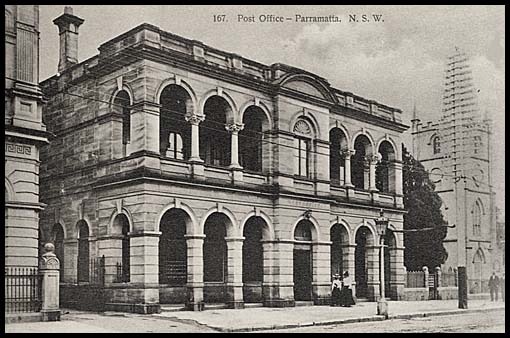 |
On 15 December 1879, the regular fortnightly meeting of the Borough Council was held. The minutes record:"The contractor for the erection of the lamp pillars for lighting certain streets with gas will have them all finished early next week and the lighting up for the first time will be on New Year's Eve. Much dissatisfaeiion is caused by the delay in finishing the Post and Telegraph Office. It is more than 18 months since the foundation stone was laid and the contractors intimated at the time that they would have it ready in nine months. More than twice that time has passed and, from all appearances it will take some time longer before it is ready for occupation. The delay is not altogether the fault of the contractors, but lies more at the door of the Colonial Architect's department. Owing to the great increase of business, the present Post Office building is totally inadequate as, during tbe past few year, the business has increased fourfold. Ten years ago the postal business was carried on by a Post Mistress and one letter-carrier. At the present time, there is a Postmaster and assistant and four letter-carriers, all of whom are fully occupied. The letters from the Western districts, whose destination is along the Southern line, are sorted here in addition to the local business. The available space in the office for all these people to do their sorting is about 10 feel by 8 foot, so that it is highly time that the new offices were ready". A public clock. "The Hon. member for Parramatta, Mr. Hugh Taylor, has been urging upon the postal authorities the necessity that exists for the erecting of a public clock in the Post and Telegraph office, Parramatta". Evening News, 1 April 1889. As an aside, several newspapers noted that "It is rumoured in Sydney that (the famous tightrope walker and acrobat) Blondin has undertaken to walk from Sydney to Parramatta on the telegraph wires. He leaves the colony shortly". |
|
|
November 1862: Mr. G. S. Pegus was appointed operator at the Telegraph Office Parramatta. April 1874: "It is with pleasure I have to notice the promotion of Mr. John Church, our present Telegraphic Station Master, to a more prominent position than the one he now holds. The station to which he is now appointed is Cowra, where I feel confident he will fill his new position with credit to himself, and honor to the appointment". June 1879: White, the Telegraph Boy, was pitched from his horse while out with a message. He was severely hurt. His left shoulder is very much bruised. He is now able to get about. 22 April 1885: Cumberland Mercury: "Mr Taylor also waited on Mr. S. Lambton, Postmaster-General and brought under his notice the great increase of business in the Parramatta Telegraph Office when the 6d. telegram rate came into force and urged that Mr. White, who has been in the Telegraph Service for over nine years, is in every way entitled to either a higher position or an increase in salary. He also pointed out the large amount of work Mr. White has done and is still doing at the Parramatta Office. Mr. Lambton assured Mr. Taylor that he would confer with Mr. Walker and see what steps could be taken in the matter". |
|
|
The earliest evidence of the operation of the Parramatta Telegraph Office is shown by:
|
|
|
An steel oval date stamp (SO6-ETD) was issued to the Telegraph Office at Parramatta. The top heading is
|
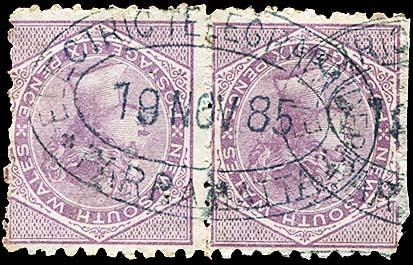 19 November 1885. |
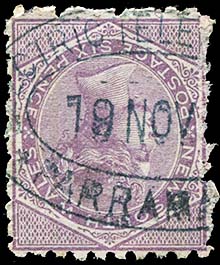 19 November (1885?). |
|
| The usual postal date stamp was used on telegrams. | 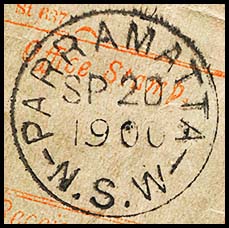 |
As an aside, the Armidale Express of 13 June 1857 reported that "a fire lately took place in George Street (Parramatta), when the shop windows, counter and various stores belonging to Mr. Sykes, were destroyed. There is a fire engine in Parramatta, but it appears there is no brigade to work it". |
|
| A Telegraph Office was opened at Parramatta Railway Station on 29 October 1858. | |
|
At first the Telegraph Office at Redfern Station was a relay station but it opened on 29 October 1858 as a full Office with the appointment of a Junior (telegraph) clerk following on 1 November 1858. No special date stamp was prepared for the office until 1895. The Telegraph Office was moved to the new Redfern Railway Station on 6 August 1906. Personnel: Mr. F. Sykes was appointed as Junion Electric Telegraph Operator. |
|
The Telegraph Office at South Head was opened on 26 January 1858. It appears as if the office was located in the Signal House. It closed on 30 May 1919. No special date stamp was prepared for the office until the 1900s. |
